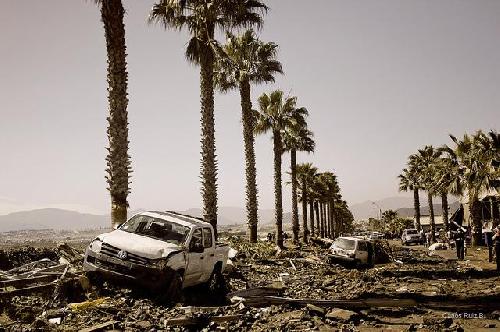After the 2011 Tohoku earthquake and devastating tsunami in Japan, states such as California, Oregon, Washington and Alaska are looking to both the past and the future to prepare for a tsunami on the U.S. Pacific coastline.
Plans for managing tsunami risk on the West Coast are evolving, said scientists speaking at the Seismological Society of America's (SSA) 2016 Annual Meeting, held April 20-22 in Reno, Nevada. These plans include everything from tsunami hazard maps that guide the development of personal and community evacuation routes to detailed "playbooks" that help harbor and port officials recommend specific action plans based on tsunami forecast data.
At the same time, geologists are searching for evidence of past tsunamis in the region to help them refine their estimates of tsunami risk. A SSA presentation by Robert Witter of the U.S. Geological Survey's Alaska Science Center, for instance, will discuss the evidence for frequent and large earthquakes and tsunamis occurring within the past 2000 years in parts of the Eastern Aleutian Islands. There are signs that these earthquakes have spanned the boundary between the locked and creeping portions of the region's megathrust fault. Earthquakes in the area could cause significant tsunami effects across the Pacific, especially in Hawaii and California.
 This is the aftermath of a tsunami in Coquimbo, Chile following the 2015 Illapel earthquake. Credit: Creative Commons photo (CC BY 2.0) by Carlos Ruiz (www.flickr.com/photos/caruba/21552748281)
This is the aftermath of a tsunami in Coquimbo, Chile following the 2015 Illapel earthquake. Credit: Creative Commons photo (CC BY 2.0) by Carlos Ruiz (www.flickr.com/photos/caruba/21552748281)
"Despite the fact that we have learned a significant amount about the earthquake sources for tsunamis, there are gaps in our understanding of past tsunamis, especially prehistoric tsunamis," says Rick Wilson, a senior engineering geologist with the California Geological Survey. "If we can demonstrate when and where tsunamis occurred in the past, that information will give us a better understanding of the return periods in these areas, and that can go into the probabilistic analyses that help us understand our hazard and risk better."
Wilson, who also serves as the science coordinator for the State of California Tsunami Preparedness and Hazard Mitigation Program, noted that more than 440,000 people have died worldwide since 1850 as a result of tsunamis. The deadly tsunamis caused by the 2004 Sumatran earthquake and the 2011 Tohoku earthquake brought increased public attention to tsunami science, warning and preparation.
At the SSA meeting, Wilson will discuss how California officials used state tsunami response playbooks to respond to a tsunami advisory issued after the September 2015 magnitude 8.3 Illapel earthquake in Chile. The playbooks were created after the 2011 Tohoku earthquake, "when there was very little consistency between communities [in California] in what they did," Wilson says. "Some evacuated their entire zone, some just evacuated their beaches." The new playbooks offer a variety of action plans depending on the size of the tsunami from a distant source, Wilson says, "which gives officials more tools at the local level so that they can make these decisions, so that it's not an all or nothing approach."
The impact of the 2011 Tohoku tsunami lingers in other ways in California. In her SSA presentation, geophysicist Lori Dengler of Humboldt State University will discuss how "Kamome," a Japanese boat caught in the 2011 tsunami that traveled across the ocean and beached near Crescent City, California in 2013, has become a powerful teaching tool in discussing earthquake and tsunami preparedness.
The future of tsunami response and preparedness might come from new technologies such as camera-bearing drones that send video messages of incoming waves to convince coastal dwellers to evacuate, says Masa Hayashi, a retired IBM engineer presenting at the SSA meeting.
And there's also the remote possibility that the trigger for a tsunami might not come from an earthquake, but from an asteroid strike on the Earth. In an SSA talk, Lawrence Livermore National Laboratory researcher Souheil Ezzedine will share data from a study that models the effects of an asteroid-generated tsunami (including the potential wave heights), on several coastline cities in the U.S., depending on the asteroid's impact off the U.S. East Coast, the Gulf of Mexico, and into the Pacific Ocean near San Francisco.
source: Seismological Society of America